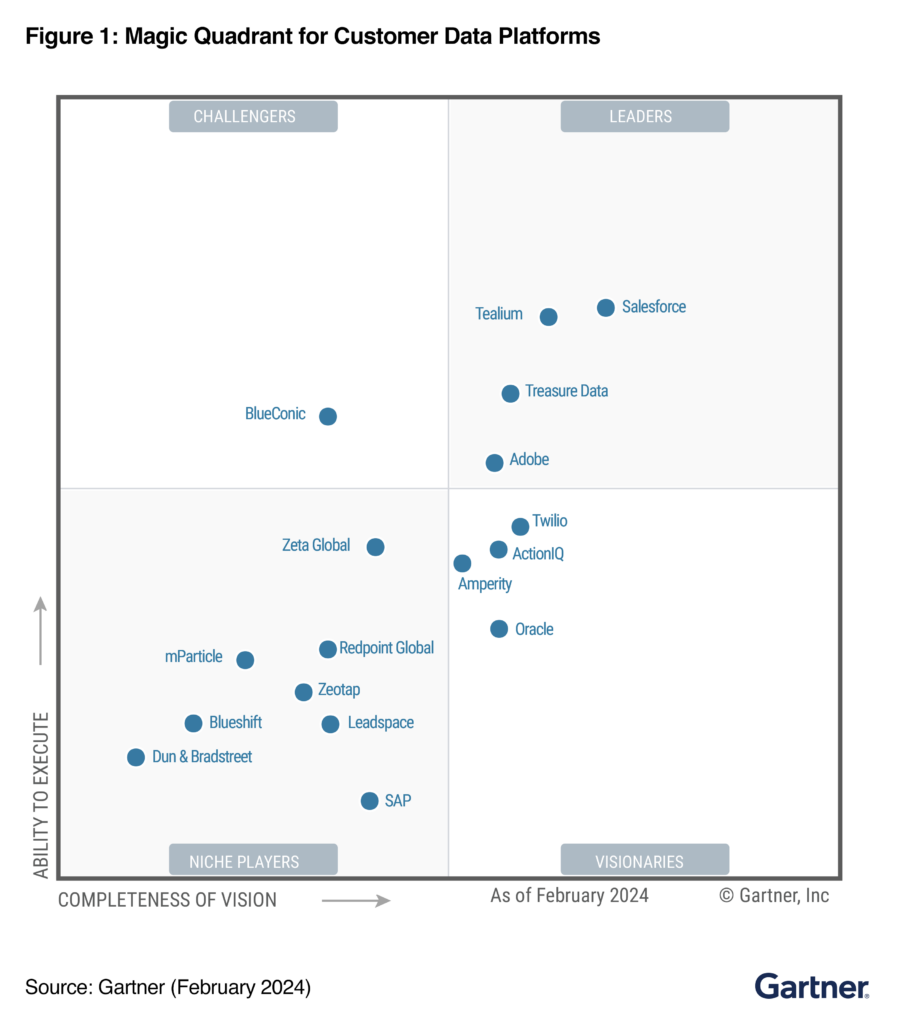Over the past decade customer data platforms (CDPs) have evolved significantly and are now positioned to be a foundational segment of the data layer in the martech solution stack. The establishment of the CDP platform as a definitive software category for advanced customer data management is evident in the fact that Gartner recently published its first ever Magic Quadrant for Customer Data Platforms. (Get a complimentary copy of the report here, courtesy of Treasure Data.)

But with break-neck growth and publicity comes the inevitable challenges. A popular new software category like the CDP will typically see vendors from related or parallel categories bolt on functionality or rebrand themselves as native CDP platforms as a marketing tactic.
Today, there are more than 180 vendors in the CDP market, with many of them not offering purpose-built CDPs, but repackaged software rebranded as a marketing CDP. Right now these rebranded CDPs are delivering underperforming business outcomes and impacting perception of the true purpose-built CDP market. This is helping to muddy the waters for customers on what a true CDP is, and what it can accomplish. Here is where the value of the new Gartner Magic Quadrant comes into play, as it puts boundaries and guardrails on a technology category like the customer data platform market.
While the definition of the CDP is ever evolving, in its new CDP quadrant Garner defines the CDP as, “software applications that support marketing and customer experience use cases by unifying a company’s customer data from marketing and other channels. CDPs optimize the timing and targeting of messages, offers and customer engagement activities, and enable the analysis of individual-level customer behavior over time.”

“The Make-Or-Break Year For CDPs”
With more mainstream adoption, many analysts believe that 2024 will prove to be a critical year for the CDP. In fact, Joe Stanhope of Forrester calls 2024 “the make-or-break year for CDPs.” While Stanhope feels the core value proposition of CDPs resonate today as much as they did when they were emerging technology a decade ago, he points to lingering issues with the category today including, “immature functionality, confusing product marketing from too many vendors, and disappointing solution results.”
As CDPs move out of the emerging technology category into mainstream adoption, it is critical that CDP vendors and marketers follow through on the promise of what the segment was originally intended for. According to Stanhope in 2024, “CDPs must own customer data for marketing, and share a true vision for supporting customer experiences.” If they don’t he warns that CDPs will lose ground to new technologies, and marketers will be forced to seek adequate solutions elsewhere.
While it is important that CDPs solidify and clarify their segment as a critical software segment like CRMs for the marketing team, it is just as critical that they are deployed across the company. Organizations can only tap into the full potential and business value of unified customer data by extending it far beyond the marketing team across every part of the customer experience, from sales to customer service.
CDPs Drive The Connected Customer Experience
According to the first-ever Gartner Magic Quadrant for CDPs, “Customer data challenges (continue to) plague marketing, sales, service, support and other enterprise customer experience functions.”
Bringing data together into a single repository so it can be combined into single unified customer profiles is what CDPs are designed to do. CDPs provide to the enterprise a single source of data-driven truth about a customer that different departments can rally around, making better decisions from the same unified data set.
Once a CDP is set up and operationalized in marketing, the unified profiles they create can be used across the business, from sales to customer service. In fact, the only way to create connected customer experiences at scale across all touch points is by all groups using the same single source of data-driven truth – a unified profile from a CDP.
CDPs Must Prove ROI
With budgets tightening today’s CFOs are checking all investments to ensure they are producing results for the business. This year it is critical that any CDP investment is showing real ROI back to the business, so they don’t end up on the budget chopping block.
According to Gartner, in 2024 CDPs are entering the Trough of Disillusionment stage of the Gartner Hype Cycle, which is a graphical representation of the maturity and adoption of technologies and applications. In the Trough of Disillusionment phase interest in the technology wanes as experiments and implementations fail to deliver as promised early on. During this phase many vendors will shake out or fail, and investments will continue only if the surviving providers improve their products to the satisfaction of early adopters. Don’t let your company fall into the trough by showing real ROI for its technology investments.
One big challenge for showing ROI back to the business for a CDP investment is some platforms take months or even years to implement, delaying time-to-value. Businesses who succeed with CDPs will get them up and running quickly and narrow in on priority use cases. For instance, one popular use case as marketing and advertising budgets tighten is media suppression. Some examples of media suppression use cases include:
- Eliminate wasted spend: A CDP allows you to identify and exclude existing customers or uninterested segments from ad campaigns, preventing wasted impressions and clicks.
- Prioritize high-value leads: CDPs enable you to focus marketing efforts on qualified leads most likely to convert, maximizing ROI. They can also suppress customer profiles who’ve recently made low-value purchases or shown minimal engagement.
- Reduce churn: CDPs identify at-risk customers and tailor retention campaigns to prevent churn. They can suppress them from generic acquisition campaigns and target them with personalized win-back offers.
With one well-executed use case or proof-of-concept (PoC), a CDP can pay for itself and prove its value to the business. In fact, a great way for a company to show value to the business for the CDP investment is to run a successful PoC use case that cuts across multiple business units. This is also what is going to help you pick the right CDP for your applications and industry. A successful PoC can show you what it will be like to actually use the CDP in action, and what the vendor will be like to work with in terms of support.
Is 2024 The Year CDPs Become Foundational Software?
2024 is poised to be an exciting and critical year for the CDP market. CDPs have moved out of the niche emerging technology sector and are poised to enter mainstream adoption as a foundational segment of the data layer in the martech solution stack.
But this growth and popularity means the stakes are higher than ever for the CDP, as vendors need to solidify their segment by clearly defining functionality and use cases, or they will lose ground to other emerging technologies that more clearly define their proposition.
With the right planning and execution by the preeminent CDP vendors, 2024 can be the year CDPs make major strides toward becoming a definitive mainstream enterprise software category like the CRM. The best CDP platforms create connected customer experiences, help solve data-oriented business challenges in marketing and beyond, all while demonstrating real-world business value and ROI.
Are you considering buying a new CDP or replacing an existing one? Check out these resources from Gartner, provided by Treasure Data, to inform your search. These research reports feature in-depth CDP rankings and CDP ratings of 17 CDPs and vendors:



